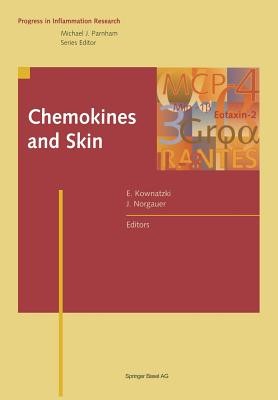
- We will send in 10–14 business days.
- Publisher: Birkhäuser
- Year: 2012
- Pages: 138
- ISBN-10: 3034897979
- ISBN-13: 9783034897976
- Format: 17 x 24.4 x 0.8 cm, softcover
- Language: English
- SAVE -10% with code: EXTRA
Chemokines and Skin (e-book) (used book) | bookbook.eu
Reviews
Description
The accumulation of white blood cells is a hallmark of inflammation. The penetra- tion through the vessel walls and the infiltration around the inflammatory stimulus is a complex process which involves active adherence and directed migration of the inflammatory cells. Chemotactic factors stimulate both adherence and migration. Technical tools such as the Boyden chamber [1] made it possible to study leukocyte migration in vitro. This technique allows differentiation between migration direct- ed towards a chemotactic stimulus and non-directed migration. Until a decade ago only two naturally occurring molecules had been clearly iden- tified as potent chemotactic attractants of neutrophilic granulocytes. They were the split product of the fifth complement component C5a [2] and the arachidonic acid metabolite leukotriene B4 [3]. In 1986, a novel human monocyte-derived chemo- taxin attracting neutrophilic granulocytes with a similar potency was found [4]. This report was quickly confirmed by several groups [5-8]. The new factor was purified, cloned and sequenced [9, 10]. The term "interleukin 8" (IL-8) replaced the various names proposed previously [4-8]. Sequence data revealed that IL-8 belonged to a large family of chemotactic cytokines, now called "chemokines" [11]. Four subfamilies were distinguished on the basis of the number and position of the first cysteine residues. They are desig- nated accordingly as C, CC, CXC and CX C chemokines [11-13]. The number of 3 human chemokines identified so far is close to 40 [11-13].
EXTRA 10 % discount with code: EXTRA
The promotion ends in 21d.00:24:57
The discount code is valid when purchasing from 10 €. Discounts do not stack.
- Publisher: Birkhäuser
- Year: 2012
- Pages: 138
- ISBN-10: 3034897979
- ISBN-13: 9783034897976
- Format: 17 x 24.4 x 0.8 cm, softcover
- Language: English English
The accumulation of white blood cells is a hallmark of inflammation. The penetra- tion through the vessel walls and the infiltration around the inflammatory stimulus is a complex process which involves active adherence and directed migration of the inflammatory cells. Chemotactic factors stimulate both adherence and migration. Technical tools such as the Boyden chamber [1] made it possible to study leukocyte migration in vitro. This technique allows differentiation between migration direct- ed towards a chemotactic stimulus and non-directed migration. Until a decade ago only two naturally occurring molecules had been clearly iden- tified as potent chemotactic attractants of neutrophilic granulocytes. They were the split product of the fifth complement component C5a [2] and the arachidonic acid metabolite leukotriene B4 [3]. In 1986, a novel human monocyte-derived chemo- taxin attracting neutrophilic granulocytes with a similar potency was found [4]. This report was quickly confirmed by several groups [5-8]. The new factor was purified, cloned and sequenced [9, 10]. The term "interleukin 8" (IL-8) replaced the various names proposed previously [4-8]. Sequence data revealed that IL-8 belonged to a large family of chemotactic cytokines, now called "chemokines" [11]. Four subfamilies were distinguished on the basis of the number and position of the first cysteine residues. They are desig- nated accordingly as C, CC, CXC and CX C chemokines [11-13]. The number of 3 human chemokines identified so far is close to 40 [11-13].


Reviews